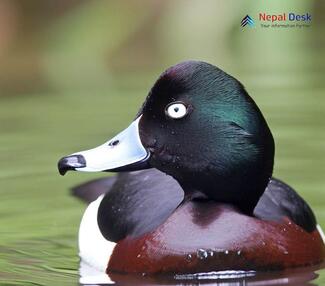The elusive Baer's Pochard (Aythya baeri) is a rare diving duck that has captured the attention of bird enthusiasts, conservationists, and nature lovers alike. With its striking appearance and unique habitat preferences, Baer's Pochard is a fascinating subject for exploration. Closely related to the ferruginous duck and also known as eastern white-eye, Siberian white-eye, Baer's white-eye, and green-headed pochard, it was first scientifically described in 1863 as Anas baeri by Gustav Radde.
In this article, we will delve into the world of this rare bird species, focusing on its presence in Nepal, a haven for diverse birdlife.
A Glimpse into the Baer's Pochard
The Baer's Pochard is notable for its attractive plumage: males have a glossy greenish-black head, chestnut brown flanks, and contrasting white undersides. Females are more muted in color but still display an unmistakable appeal with their brownish plumage and white eye-ring. This shy species favors wetlands with dense vegetation and ample aquatic plant life to support their diet of seeds, roots, aquatic plants, and small invertebrates.
A Rare Visitor to Nepal
The presence of Baer's Pochard in Nepal makes it an interesting destination for avid birdwatchers. Although Nepal is not within the main breeding range of these birds, which extends from eastern Russia to China, scattered sightings have been reported across various wetlands of Nepal. The Suklaphanta Wildlife Reserve and Rani Lake are among the sites where these rare ducks have made their appearances.
Conservation Challenges
Unfortunately, like many other species worldwide, the Baer's Pochard faces severe threats to its survival. Their rapidly declining population has led to their status as "Critically Endangered" on the IUCN Red List. Loss of suitable habitats due to wetland destruction, pollution, hunting pressure, and climate change all contribute to their dwindling numbers.
Efforts in Nepal to Protect Bird Species
Nepal has been proactive in conserving its rich biodiversity, including the Baer's Pochard and other bird species. Several national parks, wildlife reserves, and conservation areas have been established to provide protected habitats for the country's diverse avian population. Education and awareness campaigns also play an essential role in spreading understanding and appreciation for these remarkable birds.
Conclusion
The Baer's Pochard is a symbol of the rich biodiversity found in Nepal and a reminder of our responsibility to protect it. While they may be just one among many rare birds that call this Himalayan nation home, their presence adds a unique allure to the incredible tapestry of life that exists amidst the country's natural landscapes. By striving to preserve these wondrous habitats and engaging local communities in conservation efforts, we can help ensure the survival of the Baer's Pochard and countless other species for generations to come.




